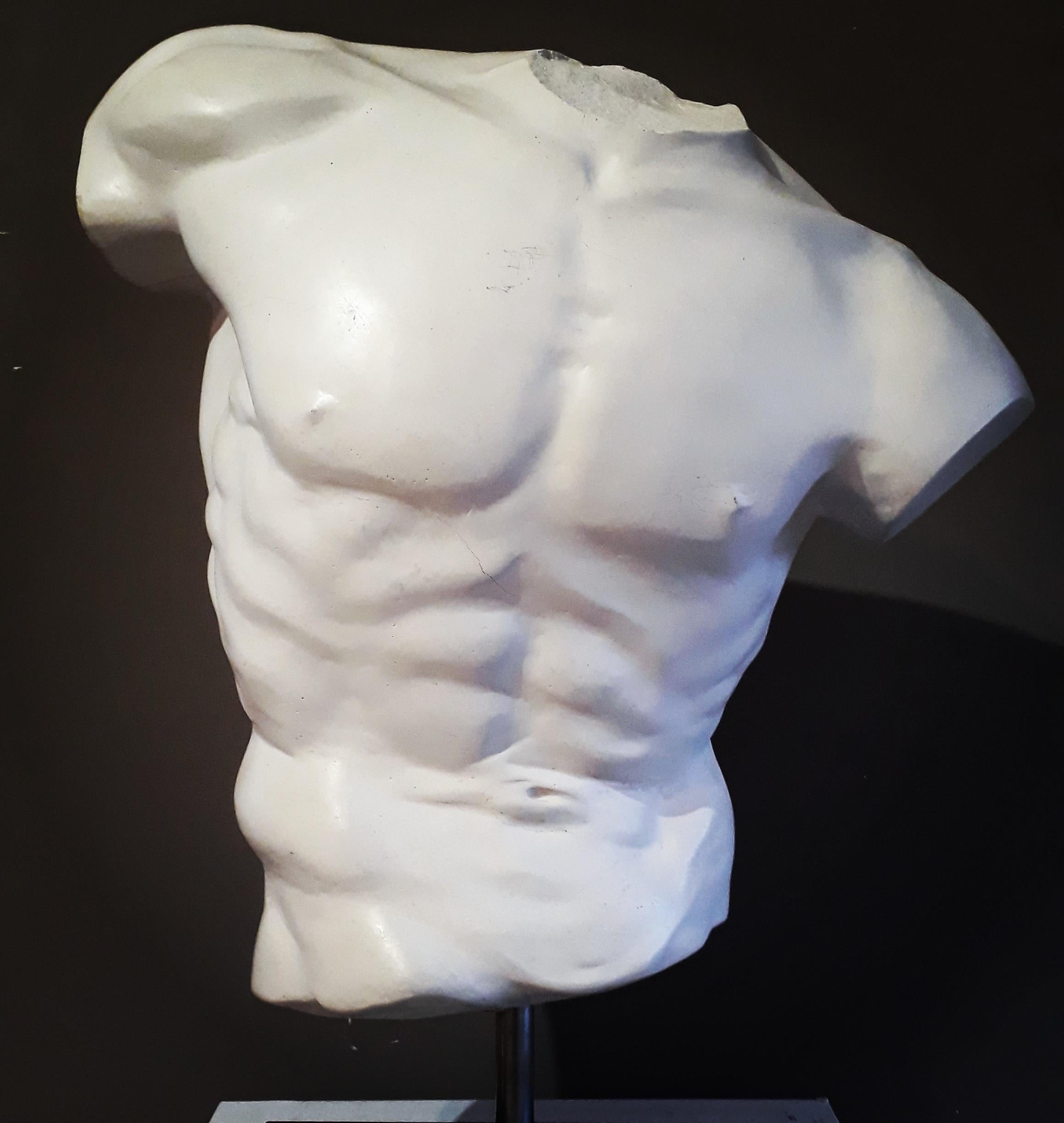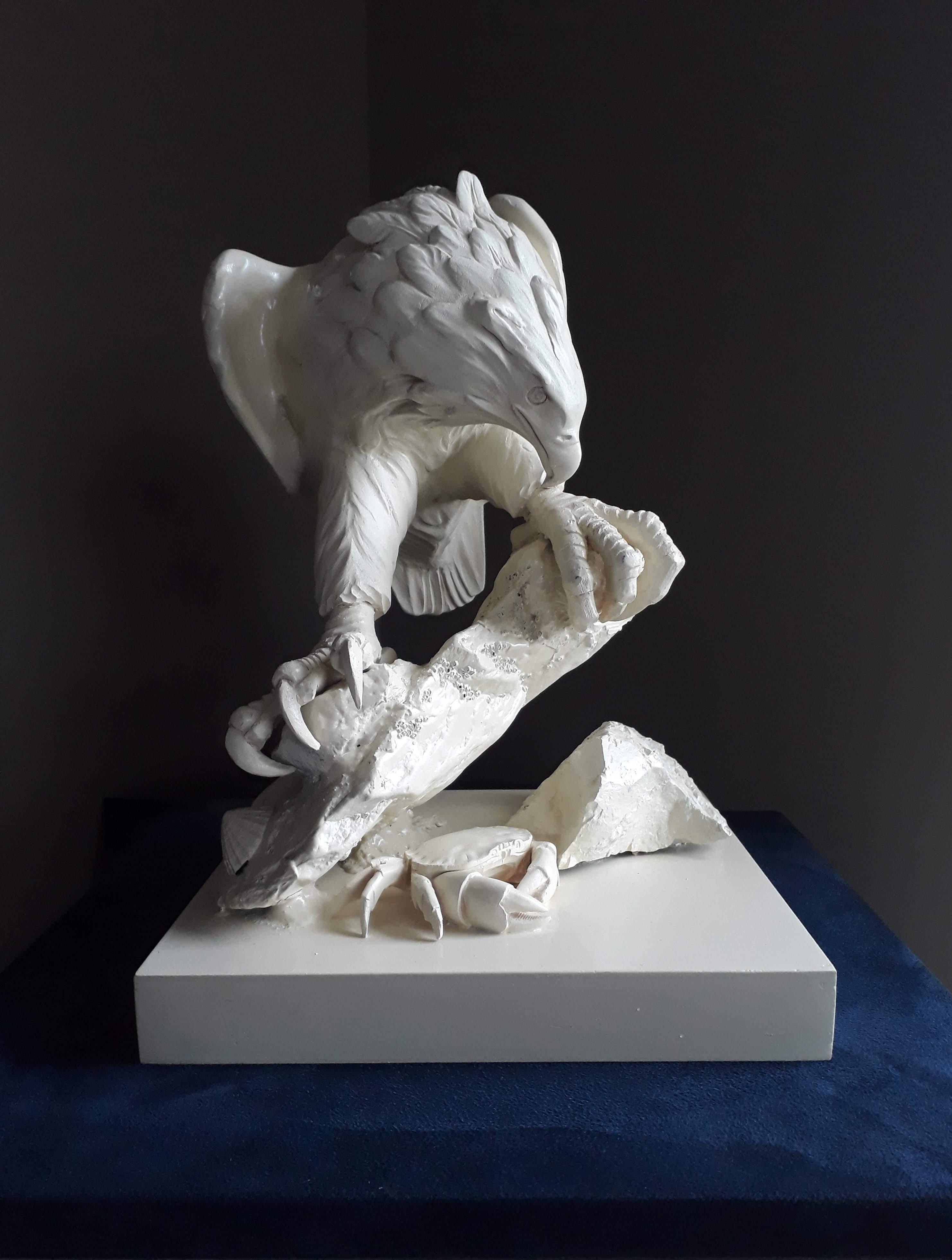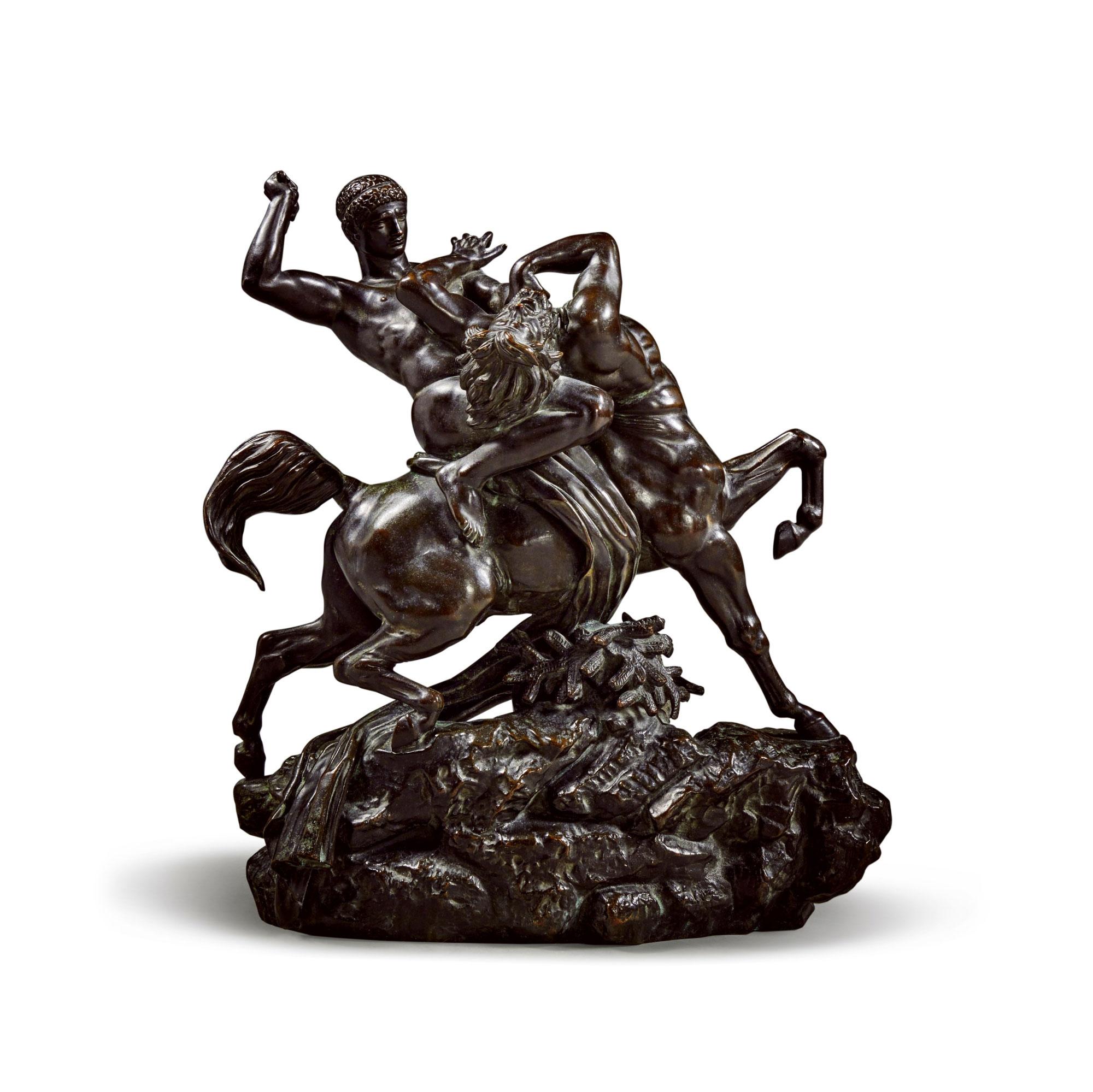Items Similar to Laocoön And His Sons Bronze
Want more images or videos?
Request additional images or videos from the seller
1 of 8
UnknownLaocoön And His Sons BronzeLate 18th/Early 19th Century
Late 18th/Early 19th Century
About the Item
Laocoön and his Sons
Italian Bronze Group after Agesander, Polydorus and Anthenodorus
Late 18th Century
“The greatest piece of art in the world.”
- Michelangelo, Italian sculptor, painter, architect and engineer
The Laocoön marble sculpture after which this remarkable bronze was modeled unquestionably influenced the lives and works of countless artists, authors, popes, kings and emperors since it was first discovered in the early 16th century. Incredibly important to the history of art, this extraordinary work and its handful of replicas are prominently displayed in the most prestigious museums around the world, from the Vatican to the J. Paul Getty. Beautifully crafted, the present bronze displays all of the dynamic artistry and poignant expression for which the original is so celebrated.
The story of Laocoön is one of the most famous in all of literature. Described by Virgil in his epic poem The Aeneid, it is the iconic tale of the famous Trojan horse. After an unsuccessful ten-year siege of the city of Troy, the Greeks craftily left a giant wooden horse outside the gates of the city with a small Greek contingency hidden inside. A cunning Greek soldier named Sinon was left to explain this unusual gift. Laocoön, the Trojan high priest who questioned Sinon, was not persuaded and began to warn the people of Troy. According to Virgil, the Goddess Minerva, eager to protect her Greeks, immediately sent two sea serpents to kill Laocoön and his twin sons before they could warn more Trojans of the deception. This bronze sculpture depicts this epic moment in all of its dramatic glory.
The original marble was carved circa 35 BC by three sculptors from the island of Rhodes and eventually came to reside in the palace of the emperor Titus. It was discovered and excavated in 1506, immediately becoming the most famous work of art in the Western world. Pope Julius II was so enthralled by it that he not only purchased it for his collection, but also paraded it through the streets of Rome. Michelangelo himself was awed and heavily influenced by this great work. His sculpture The Dying Slave, now in the Louvre, and his amazing marble Moses were directly influenced by the classical sculpture. Titian, Caravaggio and Rubens also all borrowed from the masterpiece, and acclaimed authors from Dante to Dickens took inspiration from this important work. Because it so perfectly captures the desperate struggle of all its figures, it is considered by most art historians to be the greatest sculpture conveying movement ever created.
There are just a handful of Laocoön marbles and bronzes known, most of which are housed in important museum collections across the globe. The Uffizi Museum, Vatican Museum, Hermitage and famed Sledmere House all boast large-scale marble versions. Smaller bronze versions such as this one are represented in the Louvre, the Victoria & Albert Museum and the J. Paul Getty Museum.
Late 18th/Early 19th Century
32” high x 25 1/4” wide x 9 3/4” deep
- Creation Year:Late 18th/Early 19th Century
- Dimensions:Height: 32 in (81.28 cm)Width: 25.25 in (64.14 cm)Depth: 9.75 in (24.77 cm)
- Medium:
- Movement & Style:
- Period:
- Condition:
- Gallery Location:New Orleans, LA
- Reference Number:
About the Seller
5.0
Vetted Seller
These experienced sellers undergo a comprehensive evaluation by our team of in-house experts.
Established in 1912
1stDibs seller since 2013
15 sales on 1stDibs
Typical response time: 5 hours
- ShippingRetrieving quote...Ships From: New Orleans, LA
- Return PolicyThis item cannot be returned.
More From This SellerView All
- Laocoön And His Sons By Adriaen De VriesLocated in New Orleans, LAAdriaen de Vries 1556-1626 Dutch Laocoön and His Sons Bronze A remarkable feat of artistry and skill, this bronze sculpture was created by famed Dutch artist Adriaen de Vries. Full of the swelling emotions and dramatic posing so quintessential to the period, the bronze is a masterclass in Baroque sculpture. The original Laocoön marble sculpture, after which this remarkable bronze was modeled, unquestionably influenced the lives and works of countless artists, authors, popes, kings and emperors since its re-discovery in 1506. Famously, Michelangelo declared the sculpture, created circa 35 BC, as the “greatest piece of art in the world.” Adriaen de Vries, an apprentice of the great sculptor Giambologna, undoubtedly sought to prove his skill and creative voice with his own depiction of this most famous scene. Known for his virtuosic casting technique, this rare and important sculpture embodies de Vries’ mastery. The story of Laocoön is one of the most famous in all of literature. As told by the poet Virgil, the Greeks, after an unsuccessful ten-year siege on the city of Troy, the Greeks craftily left a giant wooden horse outside the gates...Category
16th Century Baroque Figurative Sculptures
MaterialsBronze
- Bronze of Pluto Abducting Proserpine after François GirardonLocated in New Orleans, LAAfter François Girardon 1628-1715 French Pluto Abducting Proserpine Bronze This High Baroque period composition captures the famed narrative of Pluto and Proserpine from Roman mythology. The late 17th-century patinated bronze, created after François Girardon's marble composition, captures the very moment that Pluto seizes Proserpine. The anguished goddess reaches skyward, attempting to escape the god’s grasp while Pluto’s stoic face betrays his knowledge that his ploy will succeed. This pivotal moment in the mythological tale has captured the imagination of many art historical greats, from Bernini to Rubens. François Girardon’s version of the climax demonstrates incredible finesse and artistry, modeled expertly in bronze in the present work by a later sculptor. The statue brings a twist of intertwined bodies into a dynamic frenzy, paralleling the tension of the legendary story. In ancient Roman mythology, Proserpine, the beautiful daughter of Ceres — known as Persephone in Greek mythology — was picking flowers in the fields when she was suddenly abducted by Pluto, the god of the underworld, and taken to his kingdom. Consumed with grief, her mother Ceres, the goddess of agriculture, scorches the earth, stopping the growth of grain and fruit. Jupiter attempts to intervene and secure Proserpine’s return to earth, negotiating a compromise with Pluto and the Fates that allows Proserpine to be released for part of the year before returning to Pluto’s underworld. Proserpine’s journey back and forth is an allegory for the changing seasons; when Prosperine is with her mother, the earth warms and provides bountiful harvests. Upon her annual return to the underworld, however, the earth once again becomes cold and barren. After returning to France after years of training in Rome, François Girardon quickly rose to become one of the greatest artists in France. He was elected a member of the Académie Royale de Peinture et de Sculpture in 1657 and would become Chancellor of the Royal Academy in 1695. The artist was approached frequently for royal commissions and Girardon’s Pluto was originally commissioned by Louis XIV for the gardens at his Palace of Versailles. It was one of four monumental marble groups intended to decorate the corners of Charles Le Brun’s never completed garden at the chateau, the Parterre d’Eau. Each group of three figures symbolized one of the four elements: earth, air, fire and water. Pluto’s association with hell made him the apt...Category
Early 18th Century Baroque Figurative Sculptures
MaterialsBronze
- Bust of Pope Innocent XI Odescalchi by Domenico GuidiLocated in New Orleans, LAThis monumental bust is a museum-quality example of Roman Baroque sculpture. Crafted by the legendary Domenico Guidi and carved from Carrara marble, the impressive portrait captures the visage of Pope Innocent XI, Benedetto Odescalchi (1611-1689). It presents a larger-than-life example of Guidi’s remarkable skill as a sculptor, which ultimately made his workshop one of the most important in Rome during his age. Today, his works are rarely found on the market, particularly his extraordinary works in marble. Pope Innocent XI was born Benedetto Odescalchi into an Italian noble family of prominent bankers. Spending his early years in banking, he eventually turned to the law, earning his doctorate in 1639. His background would serve him well in his service to the papacy, and he became known as a frugal and devout member of the Church. In 1676, he was unanimously elected Pop after the death of Clement X. During his nearly 13-year reign, he instilled his own personal ideals of austerity and frugality onto the Church, with a deep commitment to reform and piety. He is captured here by Guidi in his traditional Pope’s mozzetta and camauro cap. A wide stole is draped over his shoulders, ornamented by acanthus leaves and the coat of arms of the Odescalchi family. It displays Guidi’s mastery over the chiaroscuro effect, particularly in the high level of contrast in his cheeks and his eyes, which Guidi achieved through various methods of high polish. A very similar portrait sculpture of Pope Innocent XI by Guidi can be found in the collection of the Royal Castle in Warsaw. The Warsaw bust belongs to a series of portraits of popes which the Odescalchi family commissioned from Domenico Guidi in the 1690s. Compared to that example, the present bust is far more dramatic, with deeper cut lines and a more precise expression. It is likely that the present piece was seen by the Odescalchi family, who ordered a similar one to be made. The piece was almost certainly intended to be displayed in a niche, given its dramatic cutting and its roughly carved back. Others of Guidi’s busts can be found in important collections throughout Italy, England and the United States, though many of these are lesser bronze repetitions. A bronze bust of the Pope Alexander VIII by Guidi is currently in the collection of the Victoria & Albert Museum (London), while a terracotta version of the same is in the Los Angeles County Museum. A bronze of Pope Alexander VIII can be found in the Princely Collection of Lichtenstein, and his impressive marble papal bust of Clement IX graces the pope’s tomb in Santa Maria Maggiore. The present bust of Pope...Category
17th Century Baroque Figurative Sculptures
MaterialsMarble
- THE LAST DAYS OF NAPOLÉON BYLocated in New Orleans, LAThis highly evocative bronze by Vincenzo Vela captures the deposed Emperor Napoléon on his deathbed, holding a map of Europe and lost in thought about what might have been. Remarkable among most portrayals of the exiled leader, this highly detailed sculpture depicts Napoléon at his most vulnerable. Nonetheless, Vela perfectly captures his still-heroic bearing, which imparts to this work a monumental quality and quiet dignity. The mate to this figure is the colossal marble at the Musée du Château de Malmaison, which was shown at the Paris Salon of 1867. The founder of the verismo movement in Italy, Vela was one of the great exponents of realism in sculpture. Born in Ligornetto, Switzerland in 1820, he studied under celebrated sculptor, Benedetto Cacciatori. He was also influenced both by the work of Tuscan sculptor Lorenzo Bartolini, who seamlessly combined neoclassicism with naturalism and the romantic painting of Francesco Hayez...Category
19th Century Realist Figurative Sculptures
MaterialsMarble, Bronze
- CoupleBy Agustín CárdenasLocated in New Orleans, LAInfused with a crisp modernity and subtle sensuality, this bronze sculpture by Cuban-born artist Agustin Cárdenas is an exceptional example of late-2...Category
20th Century Modern Figurative Sculptures
MaterialsMarble, Bronze
- Married Love by Oscar NemonLocated in New Orleans, LAOscar Nemon 1906 - 1985 Croatian Married Love Signed “Nemon” (on reverse) Bronze resin with green patina This rousing and sentimental sculpture, commis...Category
20th Century Figurative Sculptures
MaterialsBronze
You May Also Like
- Pair of 19th Century Busts by Albert Ernest Carrier-BelleuseBy Albert-Ernest Carrier-BelleuseLocated in Santa Fe, NMSigned: A. Carrier-Belluese Two large bronze matching busts of an unknown male and female 22 x 10 x 11" male 23 x 10 x 9" female Both show signs of wear with their age but are in fa...Category
19th Century Baroque Figurative Sculptures
MaterialsMarble, Bronze
- Discus Thrower's TorsoLocated in Oswestry, GBThis artwork emulates the classical statues from the ancient world, particularly with the head broken off at the base of the neck if carved in marble. In fact I went to the lengths o...Category
17th Century Baroque Figurative Sculptures
MaterialsGranite, Bronze
- GreyhoundLocated in Oswestry, GBWhat is unique about this artwork is the grace and elegance of the greyhound but designed in a most difficult stance frought with technical challenges. Yet the result offers a stance...Category
Early 17th Century Baroque Figurative Sculptures
MaterialsBronze
- Perseus and Fame proclaiming the birth of PegasusLocated in Oswestry, GBThis neo-classical style sculpture is of Perseus the son of Zues and Danae is ordered by King Polydectes to slay the gorgon Medusa. With the gift of a polished shield from Athena, a ...Category
Early 17th Century Baroque Figurative Sculptures
MaterialsBronze
- White tailed sea eagle and crabLocated in Oswestry, GBThis white tailed sea eagle is depicted here on a rock on the shore of a remote wild Scottish Isle (Outer Hebrides). Hiding beneath the rock is a brown crab...Category
16th Century Baroque Figurative Sculptures
MaterialsBronze
- Patinated Bronze Statue of Theseus and the Centaur by Antoine-Louis BaryeBy Antoine-Louis BaryeLocated in New York, NYTitle: Theseus and the Centaur Artist: Antoine-Louis Barye (1795-1875) Date: 19th Century Medium: Oil on panel Signature: Signed ‘AL BARYE’ and stamped with ...Category
19th Century Baroque Figurative Sculptures
MaterialsBronze
Recently Viewed
View AllMore Ways To Browse
Sons Of Italy
Houser Bronze
Small Antique Bronze
Bronze Scale
Bronze People
Antique Bronze Figures Bronze
Antique Classical Sculptures
Western Bronze
Original Antique Bronze Sculpture Art Sculptures
Bronze Sea
Antique Bronze Sculptures Figures
Unusual Antique Bronze
Large Greek Bronze
Bronze Goddess
Bronze Sculpture 18th
Bronze Sculpture 18th Century
Bronze 18th Italian
Small Bronze Sculpture 19th





